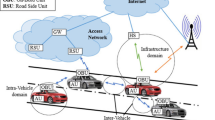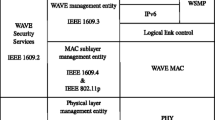Abstract
Efficient bandwidth usage is vital for real-time ad hoc networking applications like vehicular safety. Yet, such applications can produce large amounts of identical data. Pruning redundant data transmissions can enable delivering richer data to more users at shorter intervals. Reducing redundancy has been studied extensively for stable network topologies but the solutions are not directly extensible to dynamic topologies where information about network state obsolesces quickly. We compare two novel combinations of the adaptive controlled flooding routing protocol, SBSD, with implementations of response aggregation and query filtering for mobile environments. We test these combinations in simulated vehicular networks. We show that, even in cases where response aggregation only slightly improves network performance, query filtering can improve delivery by up to 30 % and response time by 75 %.














Similar content being viewed by others
References
Bai, F., & Krishnamachari, B. (2009). Spatio-temporal variations of vehicle traffic in vanets: Facts and implications. In Proceedings of ACM VANET’09, pp. 43–52.
Barr, R., Haas, Z., & van Renesse, R. (2005). JiST: An efficient approach to simulation using virtual machines. Software Practice and Experience, 35(6), 539–576.
Bononi, L., & di Felice, M. (2007). A cross layered MAC and clustering scheme for efficient broadcast in VANETs. In Proceedings of MASS 2007, pp. 1-8.
Campolo, C., Molinaro, A., & Vinel, A. (2011). Understanding the performance of short-lived control broadcast packets in 802.11p/WAVE vehicular networks. In 2011 IEEE vehicular networking conference, Amsterdam, The Netherlands.
Carzaniga, A., Rosenblum, D., & Wolf, A. (2001). Design and evaluation of a wide-area notification service. ACM Transactions on Computer Systems, 19(3), 332–383.
Chandramouli, B., & Yand, J. (2008). End-to-end support for joins in large-scale publish/subscribe systems. In Proceedings of PVLDB ‘08, Auckland, New Zealand, pp. 434–450.
Chen, R., Jin, W., & Regan, A. (2010). Broadcasting Safety Information in Vehicular Networks: Issues and Approaches. IEEE Network Magazine, 24(1), 20–25.
Choffnes, D., & Bustamente, F. (2005). An integrated mobility and traffic model for vehicular wireless networks. In Proceedings of the 2nd ACM international workshop on vehicular ad-hoc networks.
Defude, B., Delot, T., Ilarri, S., Zechinelli-Martini, J., & Cenerario, N. (2008). Data aggregation in VANETs: The VESPA approach. In First Int’l workshop on mobile and ubiquitous systems: Networks and services (MOBIQUITOUS’08), Dublin, Ireland.
Dietzel, S., Bako, B., Schoch, E., & Kargl, F. (2009). A fuzzy logic based approach for structure-free aggregation in vehicular ad hoc networks. In 6th ACM International workshop on vehicular internetworking, Beijing, China, pp. 79–88.
Dikaiakos, M., Iqbal, S., Nadeem, T., & Iftode, L. (2005). VITP: An information transfer protocol for vehicular computing. In Proceedings of the 2nd ACM international workshop on vehicular ad-hoc networks.
Ghafoor, K., Bakar, K., van Eenennaam, M., Khokhar, R., & Gonzalez, A. (2011). A fuzzy logic approach to beaconing for vehicular ad hoc networks. International Journal of Telecommunication Systems, 53(4), 330–342.
Gupta, S., Joshi, A., Santiago, J., & Patwardhan, A. (2008). Query distribution estimation and predictive caching in mobile ad hoc networks. In International workshop on data engineering for wireless and mobile access, Vancouver, Canada, pp. 24–30.
Hara, T. (2001). Effective replica allocation in ad hoc networks for improving data accessibility. In Proceedings of IEEE INFOCOM.
Ibrahim, K. (2011). Data aggregation and dissemination in ad-hoc networks. Doctoral Thesis, Old Dominion University, Norfolk, Virginia.
Jurca, O., Michel, S., Herrmann, A., & Aberer, K. (2010). Continuous query evaluation over distributed sensor networks. In Proceedings of IEEE ICDE 2010, Long Beach, California, pp. 912–923.
Jurca, O., Michel, S., Herrmann, A., & Aberer, K. (2008). Query driven operator placement for complex event detection over data streams. In Proceedings of EuroSSC, Zürich, Switzerland.
Jurca, O. (2010). A publish/subscribe approach to processing continuous queries over sensor data streams. Doctoral Thesis, EPFL, Lausanne, Switzerland.
Legendre, F., Hossman, T., Sutton, F., & Plattner, B. (2011). 30 years of wireless ad hoc networking research: What about humanitarian and disaster relief situations? What are we still missing? In International conference on wireless technologies for humanitarian relief, Kerala, India.
Lim, Y., Ahn, S., & Cho, K. (2011). Abiding geocast for commercial ad dissemination in the vehicular ad hoc network. In IEEE conference on consumer electronics, Berlin, Germany.
Lochert, C., Scheurmann, B., & Mauve, M. (2010). A probabilistic method for cooperative hierarchical aggregation of data in VANETs. Ad Hoc Networks, 8(5), 518–530.
Lundquist, D., & Ouksel, A. (2012). A Context-Aware Cross-Layer Broadcast Model for Ad Hoc Networks: Analysis of Multi-Hop Routing. Procedia Computer Science, 10, 766–774.
Nair, R., Soh, B., Chilamkurti, N., & Park, J. (2013). Structure-free message aggregation and routing in traffic information system [SMART]. Journal of Network and Computer Applications, 36(3), 974–980.
Ouksel, A., Jurca, O., Podnar, I., & Aberer, K. (2006). Efficient probabilistic subsumption checking for content-based publish/subscribe systems. In ACM/IFIP/USENIX 7th Int’l middleware conference, Melbourne, Australia.
Ouksel, A., & Lundquist, D. (2010). Demand-driven publish/subscribe in mobile environments. Wireless Networks, 16(8), 2237–2261.
Ouksel, A., & Lundquist, D. (2014). A Context-Aware Cross-Layer Broadcast Model for Ad Hoc Networks. Journal on Personal and Ubiquitous Systems, 18(4), 851–864.
Rajagopalan, R., & Varshney, P. (2006). Data aggregation techniques in sensor networks: A survey. IEEE Communications Survey Tutorial, 8(4), 48–63.
Sai, S., Oshida, T., Onishi, R., Yoshioka, A., & Tanaka, H. (2012). Comparisons of non-line-of-sight inter-vehicle communications in the urban environment between 5.9 GHz and 700 MHz bands. In 2012 IEEE vehicular networking conference, Seoul, South Korea.
Srivastava, D. (1992). Subsumption and indexing in constraint query languages with linear arithmetic constraints. Annals of Mathematics and Artificial Intelligence, 8, 315–343.
Uddin, M., Wang, H., Saremi, F., Qi, J., Abdelzaher, T., & Huang, T. (2011). PhotoNet: A similarity-aware picture delivery service for situation awareness. In Proceedings of IEEE RTSS 2011, Vienna, Austria.
Uppoor, S., & Fiore, M. (2011). Large-scale urban vehicular mobility for networking research. In 2011 IEEE vehicular networking conference, Amsterdam, The Netherlands.
van Eenennaam, B., Karagiannis, G., & Heijenk, G. (2010). Towards scalable beaconing in VANETs. In 4th ERCIM workshop on eMobility, Luleå, Sweden, pp. 103–108.
Vinel, A. (2012). 3GPP LTE versus IEEE 802.11 p/WAVE: Which technology is able to support cooperative vehicular safety applications? IEEE Wireless Communications Letters, 1(2), 125–128.
Vinel, A., Belyaev, E., Egiazarian, K., & Koucheryavy, Y. (2012). An overtaking assistance system based on joint beaconing and real-time video transmission. IEEE Transactions on Vehicular Technology, 61(5), 2319–2329.
Wisitpongphan, N., Tonguz, Ö., Parikh, J., Mudalige, P., Bai, F., & Sadekar, V. (2007). Broadcast Storm Mitigation Techniques in Vehicular Ad Hoc Networks. IEEE Wireless Communications, 14(6), 84–94.
Yang, L., Guo, J., & Wu, Y. (2008). Channel adaptive one hop broadcasting for VANETs. In 11th international IEEE conference on intelligent transportation systems, Beijing, China, pp. 369–374.
Yu, B., Gong, J., & Xu, C. (2008). Catch-up: A data aggregation scheme for vanets. In Proceedings of 5th ACM international workshop on vehicular ad hoc networking, San Francisco, pp. 49–57.
Author information
Authors and Affiliations
Corresponding author
Rights and permissions
About this article
Cite this article
Ouksel, A., Lundquist, D. Reducing redundant data transmissions in wireless ad hoc networks: comparing aggregation and filtering. Wireless Netw 21, 2155–2168 (2015). https://doi.org/10.1007/s11276-015-0890-7
Published:
Issue Date:
DOI: https://doi.org/10.1007/s11276-015-0890-7




